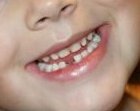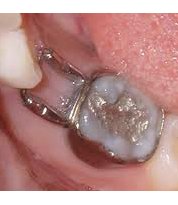|
Early Loss of Baby Teeth - Losing baby teeth too Early

Problems due to Early Loss of Baby TeethThe primary teeth are normally lost between the ages of 6 to 12 years following a more or less standard pattern. Certain conditions can cause the premature loss of a baby tooth much earlier than it would occur naturally. Early loss of baby teeth can lead to problems with the proper development and eruption of permanent teeth. Causes of premature loss of baby teethThe most common conditions that may lead to early loss of primary teeth are: TraumaFalls and injuries during play or sports may result in a baby tooth being knocked out or damaged so much that it has to be extracted. Baby teeth are not as strong as permanent ones and their roots are smaller, so they are more susceptible to injuries. Tooth decay or cariesIf a baby tooth is seriously damaged by caries, it may have to be extracted from the mouth much sooner from when it would fall out normally. Besides the loss of the primary tooth, there is a big risk for the underlying permanent tooth to become infected and be already decayed when it erupts. Baby teeth are much more vulnerable to tooth decay, for a number of reasons.
The risk of losing baby teeth due to dental caries can be significantly decreased with the use of fluoride and dental sealants. Early childhood cariesEarly childhood dental caries, also known as baby bottle tooth decay, is a type of catastrophic decay affecting children in the first years of their life. It develops frequently in infants that are put to bed with a bottle containing a sweet liquid, such as milk, formula, fruit juices, or with a pacifier dipped in honey, sugar, or syrup. Bacteria of the mouth consume this sugar producing acids. The baby’s mouth may remain an acidic environment continuously for several hours which can cause severe destruction of the baby teeth. Problems caused by losing baby teeth too earlyThe root of the primary tooth is supposed to serve the role of a guide that leads the permanent tooth to its proper place. As the root gets dissolved gradually, the adult tooth grows in the freed space coming continuously closer to the gums. When the root of the baby tooth is fully dissolved, it falls out leaving the area free for the eruption of the permanent tooth underneath it. If a baby tooth is lost prematurely for any reason before the respective permanent one is yet ready to erupt, two scenarios may cause problems:

To prevent these problems and avoid the need of extensive orthodontic treatment, dentists use space maintainers, appliances made of metal or plastic which hold free the empty space left by the lost baby tooth. They keep in place the adjacent baby teeth, preventing their movement until the permanent tooth takes its natural position in the jaw. If several baby teeth are lost too early it may affect the ability of the child to follow a proper diet and cause significant problems in speech development. The safest way to prevent possible problems due to early loss of baby teeth is to follow a schedule of regular visits to a pediatric dentist.
|
|
Dental Diseases |
Baby Teeth |

